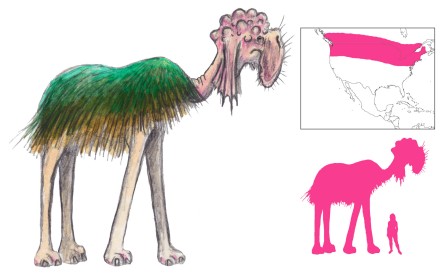Variations: Rythmopes inarticulatus (Cox), Reclinor rigidus (Tryon)

The Animal That Cannot Lie Down is a near-universal tale arrived at independently by multiple cultures and commonly attached to accounts of the moose. The Hugag is another permutation of this theme repackaged for the whimsical world of backwoods tall tales. Whether it came spontaneously into existence, was derived from native tales of the Stiff-Legged Bear, or is a bit of Classical jokery from Cox, none can say for certain.
Hugags are found in lumberwoods territory, including Minnesota, Wisconsin, and Canada, and are the largest beasts of the lumberwoods. Cox describes them as looking like enormous moose, with the chief difference being jointless legs and overdeveloped upper lips. The head and neck are hairless, covered by a leathery skin. The ears are corrugated and floppy. The feet have four toes, and the coat and long tail are shaggy. Tryon adds more detail, giving it a warty snout, a bald, lumpy head, and pine needles for hair. It stands 13 feet tall and weighs up to 6,000 pounds. Pitch oozes from its pores.
A hugag is completely incapable of lying down. It is constantly on the move, browsing from trees by wrapping its upper lip around branches, and occasionally stripping bark. Pine knots are its favorite food. It sleeps by leaning against a tree. Bent trees, posts, and cabins are signs of a hugag’s passing. Hugag hunters can easily bag their quarry by sawing almost completely through a tree, so that when a hugag leans against it the tree collapses, leaving the animal helpless on the ground. Most of the time it is difficult to find hugags, mainly because they disguise themselves as piles of pine slash. Fortunately hugags are quite harmless, barring cases when they lean on houses.
Mike Flynn is the current record-holder hugag hunter, having killed a massive 1,800-pounder on the Turtle River, Minnesota. It was a juvenile.
References
Beck, H. P. (1949) The animal that cannot lie down. Journal of the Washington Academy of Sciences, 39(9), pp. 294-301.
Cox, W. T. (1910) Fearsome Creatures of the Lumberwoods with a Few Desert and Mountain Beasts. Judd and Detweiler, Washington D. C.
Dorson, R. M. (1982) Man and Beast in American Comic Legend. Indiana University Press, Bloomington.
Tryon, H. H. (1939) Fearsome Critters. The Idlewild Press, Cornwall, NY.
This is arguably the most creative take I have seen about this critter
LikeLiked by 1 person
so cool!
LikeLiked by 1 person
Thank you 😍
LikeLike
Are we going on a “Fearsome Critter” ride?
LikeLike
There’s lots more!
LikeLiked by 1 person
hugag is my friend
LikeLiked by 1 person
For some reason, I think it’s snout is the best part of this illustration. How does this creature survive? If a wild animal bit it’s leg or something it would be done for.
LikeLike
No wonder they’re extinct :p
LikeLike